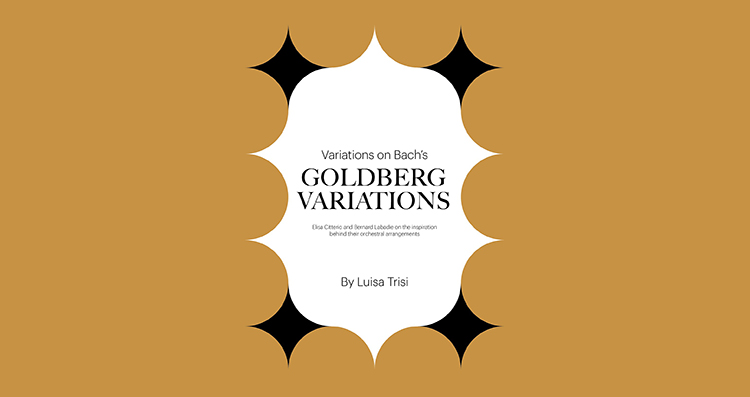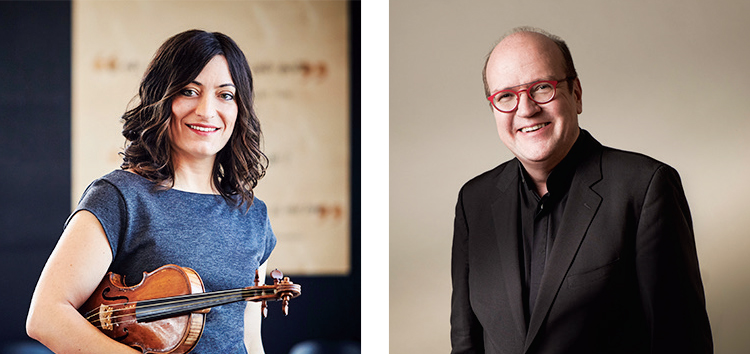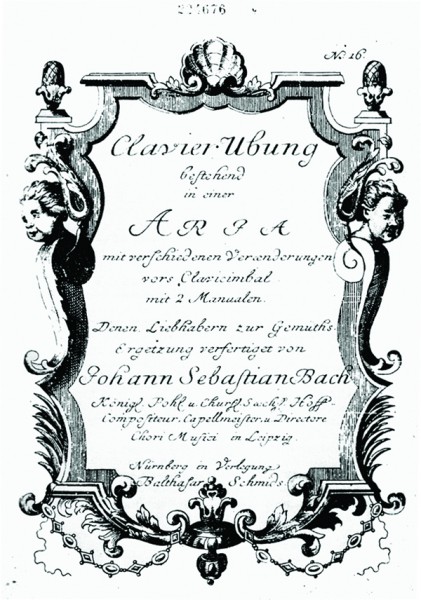This article is drawn from the second issue of Tafel: our magazine for the musically curious. Offered three times a year, this publication will, we hope, welcome new friends as well as extend the rich conversations we are already having with so many of you. Read the entire second issue here.
Variations on Bach’s Goldberg Variations
By Luisa Trisi
Elisa Citterio and Bernard Labadie on the inspiration behind their orchestral arrangements
Elisa Citterio and Bernard Labadie. Photos by Daniel Banko and Dario Acosta.
What is it about the music of Bach, specifically The Goldberg Variations, that inspires endless reinvention? With its complex beauty and astonishing symmetry, this remarkable set of variations has captured the imagination of musicians and listeners since it was first published as a work for solo harpsichord in 1741.
Fast-forward a couple of centuries. A flurry of new arrangements of Bach’s masterpiece has emerged — from orchestral remixes to renditions for solo harp, guitar ensemble, saxophone quartet, and even viol consort. Among these are adaptations by Elisa Citterio and Bernard Labadie for two renowned Canadian ensembles, Tafelmusik and Les Violons du Roy, the Quebec-based modern chamber orchestra whose playing is rooted in period performance practice.
Originally scheduled for April 2020, the world premiere of Citterio’s arrangement was to be a major highlight of Tafelmusik’s 2019/20 season, before the global pandemic forced the postponement of the program. Meanwhile, two variations (#1 and #30) — recorded remotely by musicians in their homes and stitched together through the magic of technology — were presented online as part of the orchestra’s #TafelmusikTogether initiative.
Labadie’s arrangement for strings and continuo dates back to his tenure as Music Director of Les Violons du Roy. Labadie cites a 1995 arrangement for string orchestra by Russian violinist Dmitri Sitkovetsky as the catalyst for many subsequent versions, including his own.
Pressured by his musicians to program Sitkovetsky’s popular arrangement for Les Violons’ 1996/97 season, Labadie responded by creating his own version using the same musical language as Bach and his contemporaries. “I believe an arrangement must sound idiomatic for the new medium. In the case of The Goldberg Variations, creating an idiomatic version for strings using the same instrumental forces for each variation seemed impossible to me — hence the idea of turning the whole into a huge concerto grosso, with different instrumental combinations depending on each variation.”
Title page of Bach’s own publication of “Aria with various variations for a two-manual harpsichord,” now commonly known as The Goldberg Variations.
Citterio, who was juggling parallel careers in baroque and modern violin in her native Italy, heard the 2000 Dorian recording of Labadie’s version, which was reissued on the ATMA Classique label in 2015. “I completely fell in love with the arrangement, so wonderfully played by Les Violons du Roy and so well conceived that the Variations seem originally written that way.”
Like many musicians who are not keyboard players, Citterio longed to play The Goldberg Variations. Her first tour with Tafelmusik brought her one step closer, when the orchestra performed transcriptions of two excerpts on a 2017 tour of its multimedia program J.S. Bach: The Circle of Creation.
Armed with a concept and some help from her brother, composer Carlo Citterio, she set out to complete an arrangement for strings, winds, and continuo for the core members of Tafelmusik. “With deep humility, I decided to arrange the piece because I am certain that the precious essence of Bach’s profound message remains intact despite the different timbres.”
Labadie reminds us that baroque composers, including Bach himself, were the ultimate musical recyclers. “The idea of arranging the Goldbergs makes sense from a historical perspective. For 18th-century composers, the concept of a sacred, untouchable version of something was completely unknown. Granted, The Goldberg Variations is an absolutely iconic piece of music, especially for Canadians because of Glenn Gould’s interpretations.
The Goldbergs stand as the cornerstone of the huge cathedral of work that Bach built. When you arrange such a masterpiece, you’re not replacing the original. You’re not even competing with the original, because you’re going to lose that competition.”
Citterio embraced the challenge of creating a new version, describing her arrangement as a kaleidoscope of different sonorities. “By distancing myself from the keyboard version, from the sound of a single instrument that sustains the long journey through 30 variations, I wanted to leverage the artistry of the musicians of Tafelmusik as much as possible — from solo instrument to the coupling of different instruments to orchestral tutti sections, where two oboes and a bassoon are added to the strings. I tried to imagine what sounds could best describe the images that each variation brought to mind, with the understanding that the possibilities are endless.”
In his current role as Principal Conductor of the New York-based Orchestra of St. Luke’s, Labadie conducted the American premiere of his arrangement at Carnegie Hall in 2019. “The experience reminded me how powerful this music is and how grateful musicians who are not keyboard players are when allowed the privilege of performing Bach’s Goldberg Variations.”
It’s no accident that during the pandemic, countless musicians have turned to Bach more than any other classical composer. In a world where change is the only constant, Bach’s music reminds us of that which is eternal, transcendent, and enduring. Or as Labadie says, “Bach is my feste Burg, my mighty fortress. When I was going through a very serious illness a few years ago, I naturally turned to Bach because his music is food for my soul.”
Likewise, Citterio has a powerful personal connection to the work, drawing on Bach’s timeless music for comfort, insight, and inspiration. “The Goldberg Variations is music that has been present at all the crucial moments of my life since I was a teenager. It has been described as a return journey from home and back again. The essence of the entire piece can be found in the opening Aria, from which we depart to explore marvellous places near and far, and to which we return enriched and fulfilled… and perhaps a little wiser.”
Labadie’s spontaneous and very personal response to the pandemic was Having each other’s Bach, a series of 46 daily reflections on the composer’s music. He sent these emails to more than 250 friends, colleagues, and eventually strangers, with the goal of “spreading the love of Bach in a viral way — the best vaccine there is against the gloominess of our times.”
Written against the chaotic backdrop of imposed COVID-19 lockdowns, one of Labadie’s emails aptly captures the universe according to J.S. Bach: “You feel like you are walking in a perfectly ordained world which breathes organically like a human being — and yet it brings you wonderment, surprise, and awe at every turn. That sounds like an ideal world to me.”
Luisa Trisi is the founder of Big Picture Communications, a Toronto-based company specializing in strategic communications. Luisa has been captivated by the music of J.S. Bach since her childhood piano lessons and has spent many hours obsessively listening to recordings of The Goldberg Variations.
Listen to two movements from our arrangement here.
Bernard Labadie’s arrangement is available on ATMA Classique. Listen on Spotify and YouTube.
More articles from Issue No. 2: Winter 2021
In Paradisum: Rambling in Mary's Garden
In Conversation: Pippa Macmillan and Chi-chi Nwanoku



